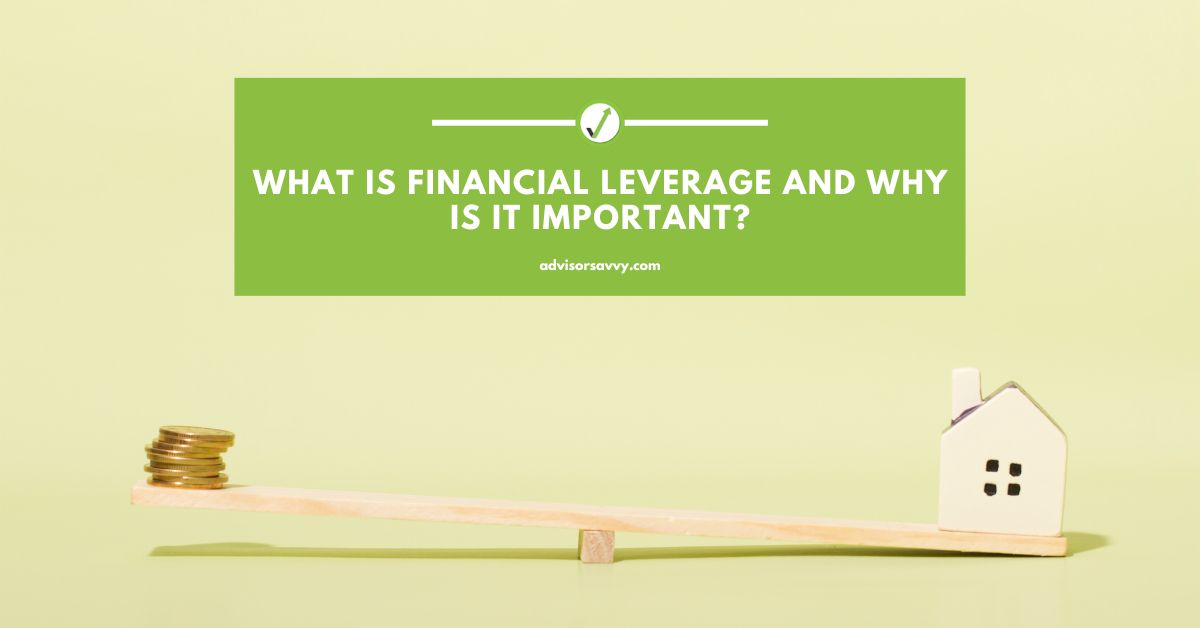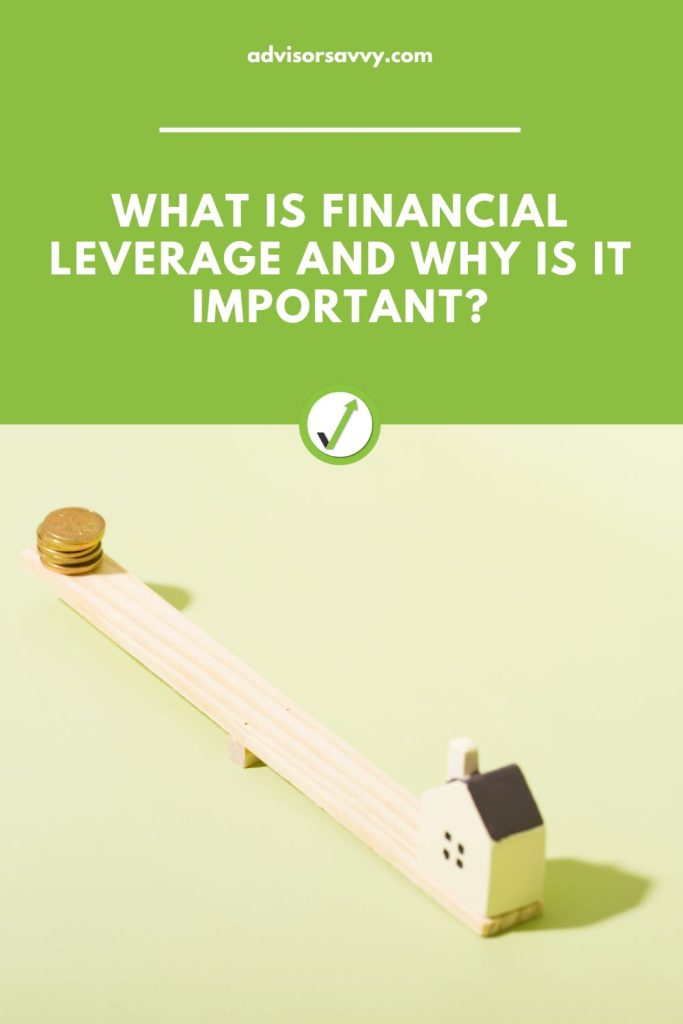
Financial leverage is an important term that often comes up in personal finance and investing. But what is financial leverage, and why is it important? In this post, we’ll define financial leverage and explain why it’s such a critical element of success for savvy investors. We’ll also look at some of the risks and benefits associated with using financial leverage. By understanding leverage, you’ll be able to make better decisions when it comes to your finances and investments.

Table of contents
What is Financial Leverage?
Using borrowed money to finance the purchase of assets with the expectation that income or capital gain from the new asset will exceed the cost of borrowing is called financial leverage. In other words, financial leverage is the process of using debt to create wealth through income producing assets or capital gain. In many cases, income produced from an asset is used to repay the obligation, such as with a rental property.
Most lenders will put a limit on how much risk they’re willing to take and what extent of leverage they’ll allow. In asset-backed lending, for example, providers use assets as collateral until borrowers fully repay loans. When unsecured personal loans are involved, general creditworthiness of an individual typically backs such loans.
Related Reading: How to Invest $1,000, $10,000 or $100,000
What is the financial leverage formula?
There are two main ways to calculate financial leverage in personal finance. One method is the debt-to-assets ratio. This ratio analyzes how much of your assets were purchased using debt. If the ratio is high, it’s an indicator that you’ve leveraged too much of your assets. The formula is as follows:
Debt-to-Assets Ratio = Total Debt / Total Assets
Another ratio you can use to assess your financial leverage is the consumer leverage ratio. The higher this ratio is, the more financially leveraged you are. If this ratio becomes too high, it can be an indicator that you’ll have difficulty securing financing in the future. The formula is as follows:
Consumer Leverage Ratio = Total Household Debt / Disposable Income
Financial leverage example
The Moore family has total household debt of $368,000 ($350,000 mortgage, $10,000 in car loans and $8,000 in other debt). Their home is currently worth $1 million and their two cars are worth $15,000 each. After expenses and debt payments, the Moore family has $150,000 in disposable income per year. Their debt-to-assets ratio is calculated as 36% ($368,000 / $1,030,000 x 100%). Their consumer leverage ratio is calculated as 2.45 ($368,000 / $150,000).
What is a good financial leverage ratio?
A financial leverage ratio is a measurement of how much debt an individual or household has relative to equity or wealth. A higher ratio means that an individual or household is more leveraged, which can be either good or bad, depending on the circumstances. An individual or household with a high leverage ratio may be able to finance their lifestyle at a lower cost, but they will also be more exposed to financial distress in the event of getting laid off or income reduction.
Generally speaking, the lower your financial leverage ratios are, the better. But if you’re able to sustain your lifestyle comfortably and aren’t looking to obtain new financing soon, then the ratio isn’t too important. On the other hand, if you’re struggling to keep up with your debt, it may be time to restructure your finances.
Related Reading: Canada Debt: How much is too much?
What is the relationship between financial leverage and risk?
By borrowing money, Canadians are able to purchase things they otherwise may not be able to afford. For instance, purchasing a home. Most Canadians don’t have enough money to purchase a home outright, so they finance it instead. A mortgage is a form of financial leverage because it’s the process of using debt to create wealth.
While financial leverage can help us achieve our goals and build wealth, it also comes with risks. Continuing with the same example above, if you run into a situation where you can’t make mortgage payments, you can run into some financial trouble. With this in mind, the more debt you acquire, the more risk you’re taking on. This is because a small change in your income or personal finances can greatly jeopardize your ability to repay debt when you’re highly leveraged.
As you can see, there is a direct relationship between risk and financial leverage. Let’s take a closer look below.
Related: Loan Calculator
Risks of financial leverage
Possible risks associated with financial leverage include the following:
Interest rate risk
When you take out a loan, you are typically required to pay interest on the outstanding balance. If interest rates rise, your loan payments will increase, which can eat into your profits or acquired wealth.
Prepayment risk
If you take out a loan with a fixed interest rate, you may be charged a penalty if you repay the loan early. This can reduce your potential investment returns. Before signing off on any loan documents, be sure to read the fine print!
Credit risk
If you default on a loan, you could lose your collateral, which could put a strain on your finances. Additionally, lenders may be less willing to extend credit to you in the future if you have a history of defaulting on loans. The same is true if you have spotty repayment history.
Related Reading: How To Build Your Credit In Canada
Liquidity risk
If you need to sell your investment in order to repay a loan, you may not be able to find a buyer willing to pay the full value of the investment. This could result in a loss or serious cash flow issues.
Default risk
If you are unable to make your interest payments, you may be forced to default on your loan. This could lead to the loss of your assets and damage your credit rating.
Volatility risk
Leveraged investments tend to be more volatile than non-leveraged investments, which means they can experience larger swings in value. This can lead to losses if you need to sell when prices are down. Ideally, you should position yourself in such a way where you don’t need to sell assets quickly when circumstances change.
Concentration risk
If you have a leveraged investment that performs poorly, it can have a disproportionate impact on your overall portfolio performance. As such, it is important to diversify your portfolio to mitigate this risk.
Related Reading: Debt and Assets Rise Among Senior Canadian Families
Benefits of financial leverage
Now that we’ve gotten the risks out of the way, let’s take a look at the benefits of financial leverage.
Increase in return on investment
By using leverage to finance the purchase of assets, you can potentially increase your return on investment. This is because you will only have to pay a portion of the cost of the asset, while reaping the financial gain.
Increased buying power
The use of leverage can increase an individual’s buying power because it allows them to purchase assets they would not be able to afford without financing. This can be an effective strategy to step up your personal finances.
Increased flexibility
Leverage gives you the ability to buy more assets than you could if you were solely relying on your own funds. This increased flexibility can be particularly helpful when opportunities arise that you would otherwise miss out on.
Improved terms
When you use leverage, you may be able to secure better terms from lenders, such as lower interest rates or longer repayment periods. This can save you money and help to make your investment more affordable. However, you must have managed previous debt effectively and continue to do so with new debt.
Potential tax benefits
In some cases, interest payments on debt used for leverage may be deductible which is tax efficient. This can further reduce the cost of your investment and improve your overall return.
Related Reading: Guide to Tax Credits: How to Get a Bigger Tax Refund
Financial leverage and your finances
When it comes to your finances, leverage is a double-edged sword. On the one hand, leverage can help you increase your returns and reach your financial goals more quickly. On the other hand, leverage can also magnify your losses and put your financial security at risk. Before you take on any new debt, it’s important to understand how leverage works and how it can impact your personal finances.
Leverage is simply the use of debt to finance an investment for future financial gain. When you borrow money to buy a house, you’re using leverage. When you invest in a stock with borrowed funds, you’re using leverage. The key is to use leverage wisely and ensure that what you’re buying will build wealth.
Too much debt can be a dangerous thing. If you’re carrying a high balance on your credit cards or you’re struggling to make your mortgage payments, your finances are already under stress. Taking on more debt can make things even worse. But if you’re strategic about how you use leverage, it can be a powerful tool for achieving your financial goals.
For example, let’s say you want to buy a rental property but you don’t have the cash to pay for it outright. You could take out a loan and use the borrowed funds to purchase the property. If the rental income covers the loan payments and then some, you’ll come out ahead financially. But if the rental income falls short or if the property value declines, you could find yourself in serious trouble.
The bottom line is that leverage can be both good and bad for your finances. It all depends on how you use it. If you’re smart about leveraging debt, it can help you achieve your financial goals more quickly. But if you’re not careful, leverage can lead to financial disaster. Be sure to think about leverage carefully before jumping in!
Read More: Asset Management vs. Wealth Management: What Is The Difference?

